Plant Kingdom NCERT
Quiz Summary
0 of 45 Questions completed
Questions:
Information
You have already completed the quiz before. Hence you can not start it again.
Quiz is loading…
You must sign in or sign up to start the quiz.
You must first complete the following:
Results
Results
0 of 45 Questions answered correctly
Your time:
Time has elapsed
You have reached 0 of 0 point(s), (0)
Earned Point(s): 0 of 0, (0)
0 Essay(s) Pending (Possible Point(s): 0)
Categories
- Not categorized 0%
- 1
- 2
- 3
- 4
- 5
- 6
- 7
- 8
- 9
- 10
- 11
- 12
- 13
- 14
- 15
- 16
- 17
- 18
- 19
- 20
- 21
- 22
- 23
- 24
- 25
- 26
- 27
- 28
- 29
- 30
- 31
- 32
- 33
- 34
- 35
- 36
- 37
- 38
- 39
- 40
- 41
- 42
- 43
- 44
- 45
- Current
- Review
- Answered
- Correct
- Incorrect
-
Question 1 of 45
1. Question
1 point(s)Examine the figure given below and select the right option giving all the four parts (a, b, c and d) correctly identified ?
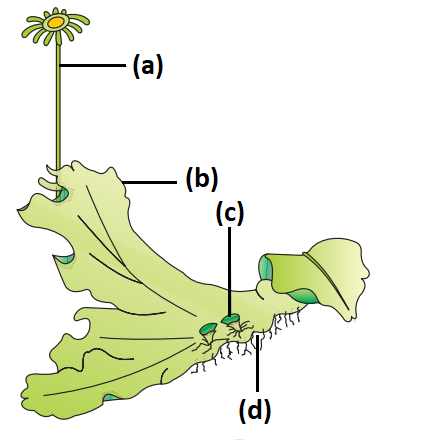
\(
\begin{array}{|l|l|l|l|l|}
\hline
& \text{A} & \text{B} & \text{C} & \text{D} \\
\hline
1. & \text{Antheridiophore} & \text{Male thallus} & \text{Globule} & \text{Roots} \\
\hline
2. & \text{Archegoniophore} & \text{Female thallus} & \text{Gemma cup} & \text{Rhizoids} \\
\hline
3. & \text{Archegoniophore} & \text{Female thallus} & \text{Bud} & \text{Foot} \\
\hline
4. & \text{Seta} & \text{Sporophyte} & \text{Protonema} & \text{Rhizoids} \\
\hline
\end{array}
\)CorrectIncorrectHint
(a)
-
Question 2 of 45
2. Question
1 point(s)Read the following statements and select the correct ones :
a. Equisetum bears strobilus
b. Pinus bears male & female sex organs on separate plant bodies
c. Volvox is a colonial alga
d. Spirogyra shows isogamyCorrectIncorrectHint
(c)
Pinus is monoecious containing both male and female on same thalli
-
Question 3 of 45
3. Question
1 point(s)Read the following statements and mark the correct option.
A. Phylogenetic classification systems assume that organisms belonging to the same taxa have different ancestors.
B. Numerical taxonomy is based on all observable characteristics.
C. Cytotaxonomy uses the chemical constituents of the plants to resolve confusions.CorrectIncorrectHint
(b)
A. At present Phylogenetic classification systems based on
evolutionary relationships between the various organisms are acceptable.
This assumes that organisms belonging to the same taxa have a common
ancestor.C. Chemotaxonomy, that uses the chemical constituents of the plant to resolve confusions,
-
Question 4 of 45
4. Question
1 point(s)Examine the figures A, B, C and D. In which one of the four options all the items, A, B, C and D are correct ?

Options:
\(
\begin{array}{|l|l|l|l|l|}
\hline & \text { A } & \text { B } & \text { C } & \text { D } \\
\hline \text { 1. } & \text { Equisetum } & \text { Ginkgo } & \text { Selaginella } & \text { Lycopodium } \\
\hline \text { 2. } & \text { Selaginella } & \text { Equisetum } & \text { Salvinia } & \text { Ginkgo } \\
\hline \text { 3. } & \text { Funaria } & \text { Adiantum } & \text { Salvinia } & \text { Riccia } \\
\hline \text { 4. } & \text { Chara } & \text { Marchantia } & \text { Fucus } & \text { Pinus } \\
\hline
\end{array}
\)CorrectIncorrectHint
(b)
-
Question 5 of 45
5. Question
1 point(s)Which of the following is incorrectly matched ?
CorrectIncorrectHint
(b)
(1) Ectocarpus – Laminarin
- ✅ Correct
- Ectocarpus is a brown alga (Phaeophyceae).
- Brown algae store laminarin and mannitol as food reserves.
(2) Ulothrix – Floridean starch
- ❌ Incorrect
- Ulothrix is a green alga (Chlorophyceae).
- Green algae store starch, not floridean starch.
- Floridean starch is found in red algae (Rhodophyceae) like Polysiphonia.
(3) Eudorina – Starch
- ✅ Correct
- Eudorina is a green alga, and green algae store starch.
(4) Fucus – Mannitol
- ✅ Correct
- Fucus is a brown alga, which stores mannitol and laminarin.
-
Question 6 of 45
6. Question
1 point(s)Observe the following characteristics:
(a) Dependent male and female gametophyte.
(b) Ovules are borne on megasporophyll.
(c) Presence of nucellus in ovule.
(d) Presence of seed
Select the correct option representing the features that are true for Cycas.CorrectIncorrectHint
(a)
-
Question 7 of 45
7. Question
1 point(s)Match List-I with List-II
\(
\begin{array}{|l|l|}
\hline
\textbf{List-I} \quad\quad\quad & \textbf{List-II} \\
\hline
\text{a. Cuscuta} \quad\quad\quad & \text{(i) Liverwort} \\
\text{b. Ectocarpus} \quad\quad\quad & \text{(ii) Angiosperm} \\
\text{c. Marchantia} \quad\quad\quad & \text{(iii) Alga} \\
\text{d. Funaria} \quad\quad\quad & \text{(iv) Moss} \\
\hline
\end{array}
\)Choose the correct answer from the options given below:-
CorrectIncorrectHint
(c)
-
Question 8 of 45
8. Question
1 point(s)Read the following statements and select the correct option:
Statement A: Phylogenetic classification systems are based on evolutionary relationships between the various organisms
Statement B: Natural classification system was given by Bentham and HookerCorrectIncorrectHint
(c)
-
Question 9 of 45
9. Question
1 point(s)Members of liverworts:-
(a) Never have leaf like appendages
(b) Have free living sporophyte
(c) Have stomata and food conducting elements
(d) Have sporophyte differentiated into foot, seta and capsule
The correct one(s) is/are:CorrectIncorrectHint
(a)
-
Question 10 of 45
10. Question
1 point(s)Mark correct w.r.t pteridophytes .
CorrectIncorrectHint
(d)
-
❌ Incorrect
-
Pteridophytes are the first vascular cryptogams.
-
They possess true xylem and phloem.
-
-
❌ Incorrect
-
Gametophyte is non-vascular in all land plants.
-
Only the sporophyte has vascular tissue.
-
Gametophytes are typically small, photosynthetic, and free-living, but avascular.
-
-
❌ Incorrect
-
Pteris is a homosporous fern.
-
It produces only one type of spore (no megaspores or microspores).
-
Megasporophylls occur in heterosporous pteridophytes like Selaginella and Marsilea.
-
-
Question 11 of 45
11. Question
1 point(s)The given diagram shows:
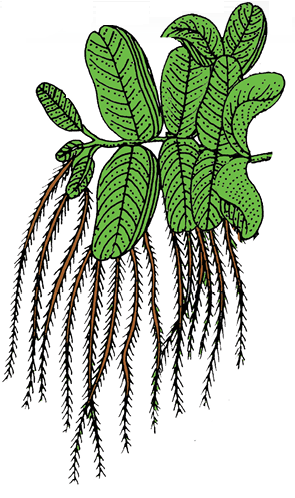 CorrectIncorrect
CorrectIncorrectHint
(c)
Salvinia
-
Question 12 of 45
12. Question
1 point(s)Read the following statements and select the correct options
Assertion (A): Sphagnum, is used as a packing material for the trans-shipment of living material.
Reason (R): Dry Sphagnum has high water holding capacity.CorrectIncorrectHint
(a)
-
Question 13 of 45
13. Question
1 point(s)In numerical taxonomy:
I. Computers are used and all the observable characters are taken into consideration.
II. Hundreds of characters can be considered together and each character is given equal importance.CorrectIncorrectHint
(c)
-
Question 14 of 45
14. Question
1 point(s)Match each item in Column I with one in Column II and select the correct match as your answer from the coders given:
\(
\begin{array}{|l|l|l|l|}
\hline & \begin{array}{l}
\text { COLUMN I } \\
\text { [Classification } \\
\text { method] }
\end{array} & & \begin{array}{l}
\text { COLUMN II } \\
\text { [Feature used] }
\end{array} \\
\hline \text { A. } & \text { Artificial } & \text { P. } & \text { Evolutionary relationships } \\
\hline \text { B. } & \text { Phylogenetic } & \text { Q. } & \text { Gross morphological characters } \\
\hline \text { C. } & \text { Chemotaxonomy } & \text { R. } & \text { Chemical constituents of plants } \\
\hline \text { D. } & \text { Cytotaxonomy } & \text { S. } & \begin{array}{l}
\text { Chromosome number, structure } \\
\text { and behaviour }
\end{array} \\
\hline
\end{array}
\)Codes:
\(
\begin{array}{|l|l|l|l|l|}
\hline & \text { A } & \text { B } & \text { C } & \text { D } \\
\hline 1 . & \text { P } & \text { Q } & \text { S } & \text { R } \\
\hline 2 . & \text { Q } & \text { P } & \text { R } & \text { S } \\
\hline 3 . & \text { R } & \text { S } & \text { P } & \text { Q } \\
\hline 4 . & \text { S } & \text { R } & \text { Q } & \text { P } \\
\hline
\end{array}
\)CorrectIncorrectHint
(b)
-
Question 15 of 45
15. Question
1 point(s)The given diagram shows:
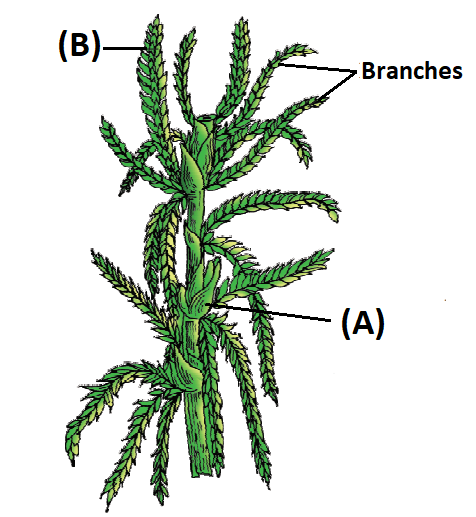 CorrectIncorrect
CorrectIncorrectHint
(d)
-
Question 16 of 45
16. Question
1 point(s)How many of the following statements is/are incorrect?
a. The leafy members of liverworts have tiny leaf like appendages in two row on the stem-like structures
b. The sporophyte in liverworts is more elaborate than that in mosses.
c. Ferns exhibit the presence of microphylls only
d. In Pinus, the pinnate leaves persist for a few yearsCorrectIncorrectHint
(c)
b. “The sporophyte in mosses is more elaborate than that in liverworts. It consists of foot, seta and capsule.”
❌ Incorrect
-
Liverwort sporophyte is simpler than that of mosses
c. 🔹 NCERT Reference:
- “The leaves in pteridophytes are small (microphylls) as in Selaginella or large (macrophylls) as in ferns.”
❌ Incorrect - Ferns have macrophylls, not microphylls.
d.🔹 NCERT Reference:
“The leaves of gymnosperms are well-adapted… Needle-like leaves of Pinus reduce the surface area.”
❌ Incorrect due to the term “pinnate”- Pinus has needle-like leaves, not pinnate (which refers to feather-like compound leaves).
- Even though they persist for years, the term is wrong, so this makes the statement incorrect.
-
Question 17 of 45
17. Question
1 point(s)Read the following statements and choose the option stating correct statements:
CorrectIncorrectHint
(b)
a. is incorrect . In chlorophyceae, pyrenoids contain protein besides starch
c. is incorrect “Red algae mostly occur in marine habitats and are found in both well-lit regions near the surface and at great depths in oceans.”
- ❌ Incorrect They are not restricted to great depths — they occur at various depths, including surface areas.
d. is incorrectThe main plant body in pteridophytes is a sporophyte which is differentiated into true root, stem, and leaves.”
- ❌ Incorrect Pteridophytes have true roots, not rhizoids (rhizoids are seen in bryophytes).
-
Question 18 of 45
18. Question
1 point(s)Which of the following statements is correct?
CorrectIncorrectHint
(d)
-
Question 19 of 45
19. Question
1 point(s)Examine the figures A, B, C, D. In which one of the four options all the items A, B, C and D are correct.

\(
\begin{array}{|l|l|l|l|l|}
\hline
& \text{A} & \text{B} & \text{C} & \text{D} \\
\hline
1. & \text{Porphyra} & \text{Fucus} & \text{Dictyota} & \text{Polysiphonia} \\
\hline
2. & \text{Polysiphonia} & \text{Porphyra} & \text{Dictyota} & \text{Fucus} \\
\hline
3. & \text{Fucus} & \text{Dictyota} & \text{Porphyra} & \text{Polysiphonia} \\
\hline
4. & \text{Porphyra} & \text{Polysiphonia} & \text{Fucus} & \text{Dictyota} \\
\hline
\end{array}
\)CorrectIncorrectHint
(a)
-
Question 20 of 45
20. Question
1 point(s)Which among the following characteristics is/are common between the members of Chlorophyceae and Rhodophyceae ?
a. Type of stored food
b. Presence of cellulose in cell wall
c. Number of flagella in a motile cell
d. Presence of chlorophyll aCorrectIncorrectHint
(c)
a. Type of stored food
🔹 NCERT Reference:
- Chlorophyceae:
- “The food is stored as starch.”
- Rhodophyceae:
- “Food is stored as floridean starch (very similar to amylopectin and glycogen in structure).”
- ❌ Not Common
- Though both are polysaccharides, floridean starch ≠ starch.
- So, the type of stored food differs.
c. Number of flagella in a motile cell
- 🔹 NCERT Reference:
- Chlorophyceae:
- “They usually have 2-8 flagella.”
- Rhodophyceae:
- “No motile stage in their life cycle.”
- ❌ Not Common
- Rhodophyceae lack flagella entirely, so this is not a shared feature.
-
Question 21 of 45
21. Question
1 point(s)Select the incorrect statement about gymnosperms.
CorrectIncorrectHint
(d)
(4) In all plants male and female cones are found on the same plant
🔹 NCERT says:
“Some gymnosperms are monoecious (e.g., Pinus), while others are dioecious (e.g., Cycas).”
❌ Incorrect
-
Not all gymnosperms have both male and female cones on the same plant.
-
Cycas is dioecious — male and female cones occur on different plants.
-
Question 22 of 45
22. Question
1 point(s)A heterosporous plant called Selaginella belongs to the class:
CorrectIncorrectHint
(b)
-
Question 23 of 45
23. Question
1 point(s)Select the true one(s) for prothallus.
a. Multicellular free living
b. Inconspicuous and small
c. Photosynthetic
d. Is diploid gametophyteCorrectIncorrectHint
(c)
d. Is diploid gametophyte
❌ False
-
Gametophytes are always haploid (n) — they arise from haploid spores (via meiosis from the sporophyte).
-
So prothallus is haploid, not diploid.
-
Question 24 of 45
24. Question
1 point(s)Consider the following statements regarding green algae:
I. Pigments are located in definite plastids
II. Most have pyrenoids in chloroplasts
III. Cell wall has an inner layer of pectose and outer layer of celluloseCorrectIncorrectHint
(a)
III. Cell wall has inner cellulose and outer pectose.
-
Question 25 of 45
25. Question
1 point(s)Examine the figures (A-D) given below and select the right option out of (a) – (d), in which all the four items A, B, C and D are identified correctly ?

\(
\begin{array}{|l|c|c|c|c|}
\hline
& \text{A} & \text{B} & \text{C} & \text{D} \\
\hline
1. & \text{Gemma cup} & \text{Archegoniophore} & \text{Sporophyte} & \text{Sphagnum} \\
\hline
2. & \text{Archegoniophore} & \text{Gemma cup} & \text{Gametophyte} & \text{Sphagnum} \\
\hline
3. & \text{Archegonia} & \text{Antheridia} & \text{Gemma cup} & \text{Sphagnum} \\
\hline
4. & \text{Antheridia} & \text{Archegonia} & \text{Gemma cup} & \text{Sphagnum} \\
\hline
\end{array}
\)CorrectIncorrectHint
(b)
-
Question 26 of 45
26. Question
1 point(s)Regarding artificial system of classification of living organisms:
I: It is the most acceptable system for classification of living organisms.
II: The vegetative characters are more easily affected by environment.CorrectIncorrectHint
(c)
Statement I:
“It is the most acceptable system for classification of living organisms.”
❌ Incorrect
-
The artificial system of classification is not the most acceptable.
-
NCERT says:
“Artificial systems gave equal importance to vegetative and sexual characteristics; this is not acceptable since vegetative characters are more easily affected by the environment.”
-
The most acceptable system is the phylogenetic system (based on evolutionary relationships).
-
Question 27 of 45
27. Question
1 point(s)The form and size of algae is highly variable. Which of the following will not be true?
I. Volvox is a colonial alga.
II. Ulothrix and Spirogyra do not form filaments.
III. Kelps form massive plants bodies.CorrectIncorrectHint
(a)
❌ II. “Ulothrix and Spirogyra do not form filaments.”
-
False. Both are well-known filamentous green algae—Ulothrix grows as unbranched filaments and Spirogyra forms long spiral chloroplast-bearing filaments
-
Question 28 of 45
28. Question
1 point(s)Identify the incorrectly matched pair:
\(
\begin{array}{|l|l|l|}
\hline & \text { Alga } & \text { Sexual reproduction } \\
\hline \text { I. } & \text { Ulothrix } & \text { Isogamous; non-flagellated gametes } \\
\hline \text { II. } & \text { Spirogyra } & \text { Isogamous; flagellated gametes } \\
\hline \text { III. } & \text { Udorina } & \text { Anisogamous } \\
\hline \text { IV. } & \text { Fucus } & \text { Oogamous } \\
\hline
\end{array}
\)CorrectIncorrectHint
(c)
-
Question 29 of 45
29. Question
1 point(s)Consider the given statements:
I: Algin is a hydrocolloid derived from brown algae.
II: Carrageen is a hydrocolloid derived from green algae.
III: Agar is a complex polysaccharide derived from red algae, Gelidium and Gracilaria.CorrectIncorrectHint
(d)
❌ II. Carrageen is a hydrocolloid derived from green algae
This is incorrect. Carrageenan comes from red algae, not green algae.
-
Question 30 of 45
30. Question
1 point(s)Given picture is of a bryophyte. The correct ploidy levels of the indicated structures are :
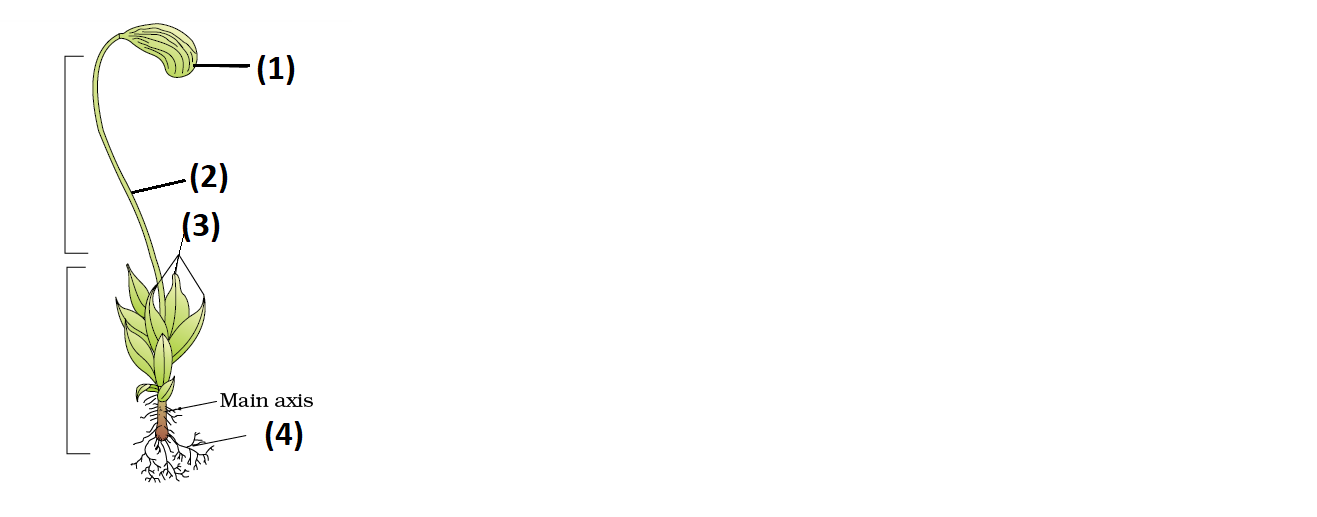 CorrectIncorrect
CorrectIncorrectHint
(a)
-
(1) – Capsule
-
Part of the sporophyte
-
Ploidy: 2n
-
-
(2) – Seta (stalk of sporophyte)
-
Part of the sporophyte
-
Ploidy: 2n
-
-
(3) – Leafy gametophyte leaves
-
Part of the gametophyte
-
Ploidy: n
-
-
(4) – Rhizoids and main axis of gametophyte
-
Part of the gametophyte
-
Ploidy: n
-
-
Question 31 of 45
31. Question
1 point(s)Consider the two statements regarding Chlorella:
Statement I: It is single-celled green algae.
Statement II: It is used as a food supplement.CorrectIncorrectHint
(c)
-
Question 32 of 45
32. Question
1 point(s)Which of the following feature given in column I is not correctly matched with its correct description given in Column II with respect to members of Chlorophyceae?
\(
\begin{array}{|l|l|l|}
\hline \text { } & \text { COLUMN I } & \text { COLUMN II } \\
\hline \text { 1. } & \text { Main photosynthetic pigment } & \text { Chlorophyll } \mathrm{a}, \mathrm{~b} \\
\hline \text { 2. } & \text { Cell wall } & \begin{array}{l}
\text { Inner layer of cellulose and outer } \\
\text { layer of pectose }
\end{array} \\
\hline \text { 3. } & \text { Stored food } & \text { Starch } \\
\hline \text { 4. } & \text { Flagellar number and insertion } & \text { 2-8. unequal. basal } \\
\hline
\end{array}
\)CorrectIncorrectHint
(d)
2–8 flagella, equal in size, apically inserted
-
Question 33 of 45
33. Question
1 point(s)Regarding the size and form of brown algae:
I. Ectocarpus is profusely branched and may reach a height of 100 meters.
II. Kelps are simple branched filamentous brown algae.CorrectIncorrectHint
(a)
I. Incorrect. Ectocarpus is actually a small filamentous brown alga, typically only a few cm long (up to about 30 cm)—it definitely does not grow anywhere near 100 meters
II. Incorrect. Kelps are large, complex brown algae with multicellular thalli, specialized structures (stipes, blades, holdfasts), and can grow tens of meters long. They are not simple filamentous forms.
-
Question 34 of 45
34. Question
1 point(s)All the following statements will be true for brown algae except:
CorrectIncorrectHint
(c)
“Vegetative cells have chitinous wall usually covered on the outside by a gelatinous coating of algin.”
This is incorrect—brown algal cell walls are not chitinous; they consist of cellulose and algin, without chitin
-
Question 35 of 45
35. Question
1 point(s)In brown algae:
I. Asexual reproduction is by biflagellate zoospores that are pear shaped and have two unequal and laterally attached flagella.
II. The gametes are pyriform [pear shaped] and bear two laterally attached flagella.CorrectIncorrectHint
(d)
-
Question 36 of 45
36. Question
1 point(s)Sexual reproduction is oogamous and accompanied by complete post-fertilization developments in members of:
CorrectIncorrectHint
(c)
-
Question 37 of 45
37. Question
1 point(s)A plant shows thallus level of organization. It shows rhizoids and is haploid. It needs water to complete its life cycle because the male gametes are motile. Identify the group to which it belongs to.
CorrectIncorrectHint
(d)
-
Question 38 of 45
38. Question
1 point(s)What is not true regarding bryophytes?
CorrectIncorrectHint
(a)
Zygote do not undergoes reduction division immediately.
-
Question 39 of 45
39. Question
1 point(s)The economic importance of bryophytes include:
I. A moss provides peat used as a packing material
II. They are early colonizers of land in ecological succession
III. They can decompose rocks
IV. They can prevent soil erosionCorrectIncorrectHint
(d)
-
Question 40 of 45
40. Question
1 point(s)Consider the two statements:
Statement I: Bryophytes usually occur in damp, humid and shaded localities and are not truly ‘successful’ on land.
Statement II: They are dependent on water for sexual reproduction.CorrectIncorrectHint
(b)
-
Question 41 of 45
41. Question
1 point(s)Regarding Marchantia:
I. The thallus is dorsi-ventral and closely appressed to the substrate.
II. The plant is monoecious.CorrectIncorrectHint
(c)
Plant having separate male and female reproductive structures so it is unisexual or dioecious.
-
Question 42 of 45
42. Question
1 point(s)The given diagram shows:
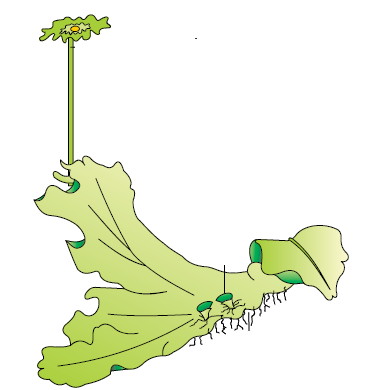 CorrectIncorrect
CorrectIncorrect -
Question 43 of 45
43. Question
1 point(s)Consider the given statements regarding Mosses:
I. Protonema is a gametophyte stage that is creeping, green, branched and frequently filamentous.
II. Leafy stage bears sex organs and is attached to the soil through multicellular and branched rhizoids.
III. Sex organs are produced at the apex of the leafy shoot.
IV. They have an elaborate mechanism of spore dispersal.CorrectIncorrectHint
(d)
-
Question 44 of 45
44. Question
1 point(s)Identify the incorrect statement:
CorrectIncorrectHint
(c)
Statement 3 is incorrect:
-
“Selaginella has macrophylls like ferns.”
-
This is incorrect. Selaginella (a lycophyte) has microphylls—small, simple leaves with a single vein. Macrophylls are found in ferns, not Selaginella
-
-
Question 45 of 45
45. Question
1 point(s)Consider the given two statements:
Statement I: In Cycas, the pinnate leaves persist for a few years.
Statement II: In conifers, the needle-like leaves reduce the surface area helping to reduce water loss.CorrectIncorrectHint
(c)